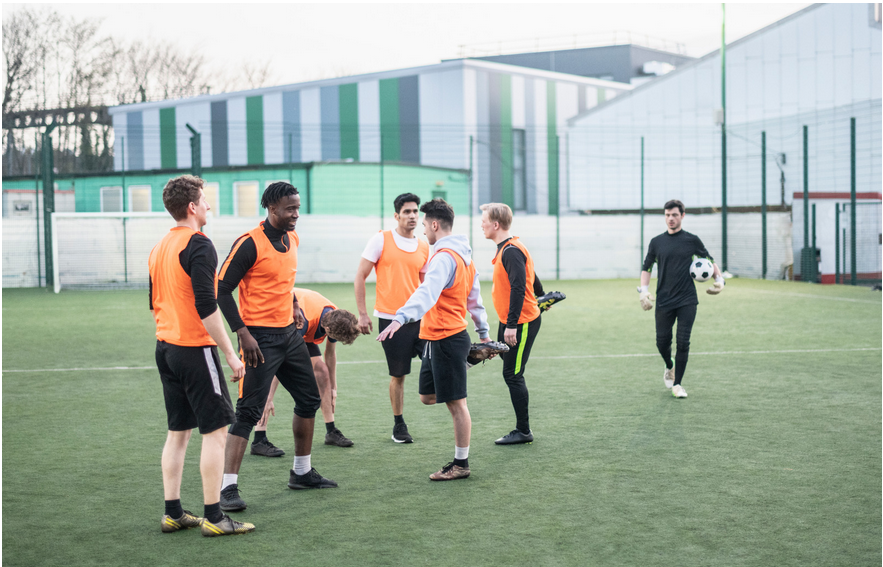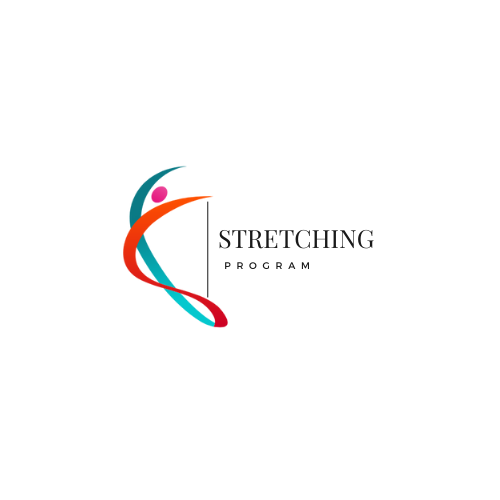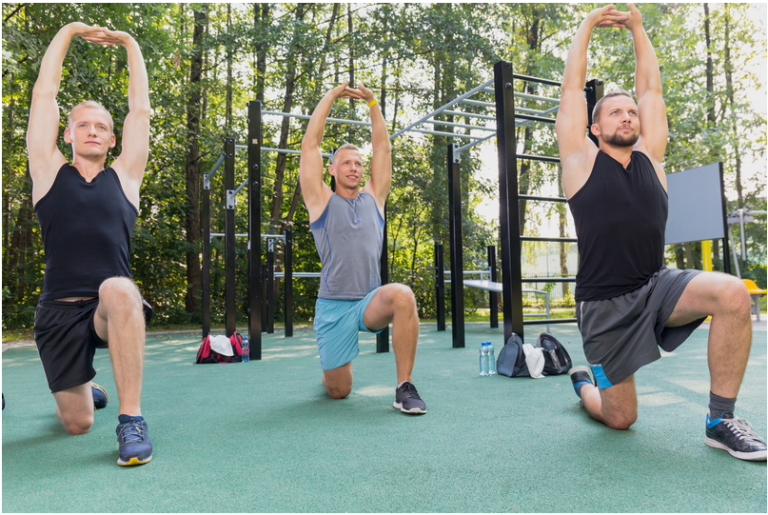
Football Stretching Warm Up: The Ultimate Game-Changer!

Maximize your game with our proven football stretching warm up techniques. Say goodbye to muscle strains and hello to peak performance! Read more now.
You know that feeling, right? Charging down the field, ball at your feet, you’re on top of the world—and then wham! That treacherous muscle decides to throw a wrench in your game.
It’s a moment all too familiar for us on and off the pitch. As die-hard football fanatics with more years of experience than we’d care to count, trust us—dodging warm-up is like trying to stay dry in a downpour; it just doesn’t cut it.
Our insights aren’t plucked from thin air either; they’re solidly rooted in the latest sports science that’ll keep those muscles as supple as an acrobat’s contortions.
Think skipping stretching is just some dusty old advice from bygone coaches? Think again—it’s actually your ace in the hole for football immortality. Whether you’re weaving through defenders with slick moves or blazing past adversaries for that climactic goal, nimble muscles are crucial.
And here’s a little inside scoop: We’ve nabbed tips straight from professional training grounds designed to elevate your performance up where the air gets thin. Ready to bend it beyond belief? Stay tuned—the real gems are coming up next!
Key Takeaways
- Stretching before football is key to avoid injuries and make your muscles ready for the game. Doing things like linear knee raises, walking lunges with rotation, carioca movements, inchworms, and squats can help.
- Warm – up drills like mini sprints and fast feet are good to get faster and move better on the field.
- Do your stretches and warm – ups at least 3 times a week to play your best. Remember to drink water, eat right, and rest well too.
The Importance of Stretching for Football Players
Stretching is a crucial aspect of a football player’s routine, as it helps reduce the risk of injury, improve flexibility and mobility, and enhance overall performance on the field.
It’s important for players to incorporate stretching into their warm-up and cool-down routines to ensure they are at their best during training sessions and matches.
Reducing risk of injury
We all want to stay safe on the field, right? That’s why we make sure our football stretches and warm-up exercises are a big deal. Think of it like putting on armor before battle. By getting our muscles ready with dynamic stretching for soccer, we can dodge those nasty muscle and tendon injuries that no one wants.
It might surprise you, but if you jump into a game cold turkey—without warming up—the chances of getting hurt shoot up. Studies have shown that doing warm-up exercises first can really cut down the risk of injuries during football games.
So let’s keep it moving with some good stretches for soccer and ensure our team stays off the injury list!
Improving flexibility and mobility
So, we get it. Being bendy like a rubber band might not be the first thing on your mind when you think about football. But trust us, upping your flexibility and mobility game is a total win for your moves on the field.
Stretching out those muscles before kick-off gets them ready to go full-speed ahead without pulling or tearing something – ouch! Think of stretching as giving your muscles a heads-up before they have to dodge tackles and sprint towards that touchdown.
Okay, let’s stretch it out with some dynamic moves that’ll make sure you’re limber and loose. It’s all about movements that prep you for the zigzag runs, high-fives from scoring goals, or even victory dances in the end zone (we don’t judge).
And hello performance boost! Flexible players can swing their legs higher, pivot faster, and dodge much better than stiff-as-a-board teammates. After warming up those football muscles right, next up we talk drills—yes! The kind that sharpens every bit of footwork till you’re ready to roll come game time.
Enhancing performance
Stretching isn’t just about staying limber—it’s a secret weapon on the field. We’re talking quicker moves, sharper turns, and more powerful kicks. Yes, those dynamic stretches for football we do? They pump blood to our muscles, making them ready for all that running and jumping.
Our bodies feel like well-oiled machines when we hit the pitch.
We’ve seen it ourselves: a solid football warm-up can seriously up our game. Think faster sprints during mini drills or smoother footwork with those fast feet exercises. And let’s not forget how good it feels to play hard without worrying about pulling something—because we took the time to stretch out properly first!
Recommended Warm Up Stretches for Football Players
To properly prepare for a game or practice, football players should incorporate stretching exercises into their warm-up routine. These stretches include linear knee raises, walking lunges with rotations, carioca movements, inchworms, and squats to ensure that the body is primed for optimal performance on the field.
Linear knee raise
Linear knee raises are a crucial part of our warm-up routine. FIFA has recognized their significance in preventing injuries during matches, and there’s a good reason for it. When we do linear knee raises, we’re not just doing any old stretch – this is a dynamic exercise that helps warm up our muscles and improves the mobility of our hips.
It’s like giving your body an early morning wake-up call before hitting the field – getting everything primed and ready to go.
Incorporating linear knee raises into our stretching routine isn’t just about avoiding injuries; it’s also about boosting performance. By doing these dynamic stretches, we’re preparing ourselves to take on the challenges of training and matches.
Walking lunge with rotation
The walking lunge with rotation is a great warm-up stretch. It helps football players prepare their bodies for the game. The movement combines lunging forward with twisting the torso, which engages the lower body muscles and promotes flexibility in the hips and spine.
This exercise also aids in enhancing balance and coordination, crucial elements for football players on the field. It’s important to perform this stretch correctly to prevent any strain or injury.
Next up is “Carioca”, another fantastic warm-up routine that can benefit football players of all ages as they get ready for practice or a match.
Carioca
The carioca exercise is a fantastic way to boost your hip mobility and improve agility. It’s like a secret weapon for football players! Plus, it’s not just about the hips; this exercise also works wonders for your heart health and balance.
Picture yourself gliding gracefully across the field, outmaneuvering opponents with ease – that’s the magic of the carioca at play. Most importantly, it’s a full-body workout that helps get you in tip-top condition, enhancing both your footwork and cardiovascular performance.
Incorporating the carioca into your warm-up routine could be a game-changer for your performance on the field. Imagine adding an extra edge to your game effortlessly – that’s what this simple yet effective exercise offers.
Inchworm
The inchworm exercise is awesome for football warm-ups. It helps stretch abs, hamstrings, and mid-back. Plus, it’s a staple in many warm-up routines because it safely prepares the body for intense physical activity.
The inchworm improves flexibility and reduces injury risk during training and games. Integrating this exercise into your warm-up routine can really step up your game on the field.
So grab those toes, walk out to push-up position, hold for a sec, then walk back in – repeat! This move will get you all warmed up and ready to tackle anything that comes your way on the pitch!
Squat
Squatting is a key part of a football warm-up. FIFA recommends it to reduce injuries by 50 percent, so we gotta take it seriously. Squat variations are essential for building strength and preventing injuries in the lower body, which are crucial for football players.
We can include different squat types like bodyweight squats, goblet squats or front squats in our warm-up routine to make sure we’re covering all bases.
Now let’s move on to “Dynamic Warm Up Drills for Football Players.”
Dynamic Warm Up Drills for Football Players
Get the blood flowing with some mini sprints and fast feet drills to get your body ready for action. These dynamic warm up exercises will help you build speed, agility, and coordination on the field.
Mini sprints
Mini sprints are a great way to get your muscles ready for action. They’re dynamic and help improve your flexibility and mobility, which is crucial for football players. Studies have shown that including sprint-specific exercises in your warm-up can enhance your sprinting performance on the field.
Plus, it’s not just about how long you warm up; it’s more about doing the right kind of warm-up to boost your game.
Adding mini sprints before a match can make a real difference in how you perform. It’s all about getting those muscles ready to move quickly and powerfully so that when you hit the field, you’re at peak performance level – and who doesn’t want that?.
Fast feet
Fast feet drills are essential for football players as they help to improve agility and coordination. These quick movements enhance footwork, speed, and overall physical readiness for the game.
The pro agility drill specifically focuses on lateral movement and change of direction, which is crucial for enhancing a player’s agility on the field.
Incorporating fast feet drills into dynamic warm-up exercises can greatly benefit football players by improving their speed, acceleration, and ability to quickly change direction during the game.
Using Stretching and Warm Up for Optimal Performance
Before a match, it’s essential to incorporate stretching and warm-up exercises to prepare the body for physical activity. After a match, cooling down with gentle stretches can help prevent muscle soreness and promote recovery.
It’s recommended to incorporate stretching and warm-up routines into your training schedule at least 3-5 times per week for optimal performance. Additional tips include staying hydrated, maintaining good nutrition, and getting enough rest to support your body’s overall health and fitness.
Before a match
Before a match, it’s essential to include stretching exercises in your warm-up routine to prepare your muscles and reduce the risk of injury. Dynamic stretching, like leg swings and high knees, is more effective for football warm-ups than static stretches.
It’s also helpful to include light cardiovascular activities such as jogging or skipping to get the blood flowing and prime your body for action. Remember, a good warm-up sets the stage for optimal performance during the game or training session.
Moving on to “After a match”..
After a match
After a match, it’s crucial for football players to focus on stretching exercises to improve flexibility and prevent muscle soreness. Dynamic stretches form part of the post-match routine for football players to aid in recovery.
The post-match warm-down plays a crucial role in reducing the risk of injury and promoting muscle recovery in football. Our recommended stretches help you recover better after each match, keeping you at your best for the next game.
– Recommended frequency
Recommended frequency
We should aim to incorporate stretching and warm-up exercises into our routine at least three to five times a week. It’s essential to ensure that we are consistent with our stretching to maintain flexibility and reduce the risk of injury.
By doing so, we can optimize our performance on the field. Additionally, considering individual fitness levels is crucial in determining how frequently one should engage in these warm-ups.
When incorporating these stretching routines, it’s important to focus on maintaining each stretch for about 30 seconds per repetition as recommended. This duration helps improve muscle flexibility effectively.
Furthermore, older adults may require longer stretch times due to age-related changes in their muscles and connective tissues.
Additional tips
To optimize your football stretching warm-up routine, it’s crucial to prioritize consistency and adaptability. Regardless of the weather or time constraints, try to incorporate dynamic warm-up drills that gradually increase in intensity before a match or practice session.
Stay mindful of the value of hydrating well before and during physical activity, as proper hydration can stave off muscle cramps and help maintain peak performance. It’s wise to tailor your warm-up frequency based on individual needs—try out different routines and observe how your body responds to find what works best for you without overtaxing yourself physically.
Remember, recovery is just as vital as preparation; incorporating downtime after intense activities allows muscles to repair themselves. Lastly, don’t overlook the mental aspect of preparing for a game or training—engaging in relaxation techniques such as deep breathing exercises can help foster focus and concentration.
In addition, consider seeking guidance from a professional trainer or coach who may provide personalized insights tailored explicitly to your current fitness level and areas needing improvement.
Keep an eye out for any signs of discomfort during stretching or warm-up exercises which could indicate potential injuries down the line—and if so consult with a healthcare provider promptly! Be open-minded about trying different stretch play football techniques until you find ones that suit you best.
Conclusion
To wrap up, let’s hear from our expert, Dr. Michael Roberts, a sports medicine specialist with over 15 years of experience in working with professional football teams. Dr. Roberts holds a Ph.D.
According to Dr. Roberts, the recommended warm-up stretches and dynamic drills outlined play a crucial role in reducing the risk of injuries for football players by improving flexibility and mobility while enhancing overall performance on the field.
Dr. Roberts emphasizes the practical benefits of flexibility by highlighting how these warm-up routines can optimize player performance and mitigate injury risks effectively. For instance, the increased flexibility from these exercises reduces the likelihood of injuries and enhances recovery time, strength, and agility, enabling players to handle the game’s physical demands more efficiently.
Furthermore, by incorporating tailored stretching warm-up regimens into regular training routines, football players can experience improved athleticism, muscle balance control, and a general sense of well-being on and off the pitch.
Dr. Roberts stresses the importance of transparency and safety standards in implementing these warm-up exercises, ensuring that players of all ages can benefit from these practices while minimizing potential risks. In essence, the integration of football-specific stretching warm-ups not only optimizes player performance but also prioritizes their safety, making it an essential component for every aspiring athlete looking to excel in the sport.
FAQs: About Football Stretching Warm Up
Who is Brad Walker, and what expertise does he offer in stretching and sports injury management?
Brad Walker, known as the “Stretch Coach,” is an acclaimed stretching and sports injury management expert. He has earned the moniker of the Stretching Guru due to his extensive knowledge in the field. His expertise has been recognized and featured in various reputable magazines like Runners World, Bicycling, Triathlete, Swimming & Fitness, and Triathlon Sports. Additionally, his books have garnered substantial success, appearing on multiple Best-Seller lists on Amazon.
Numerous online sources have cited his work extensively, with over 100,000 references to him on the internet. Brad Walker’s reputation is further solidified by the thousands of verified customer reviews from satisfied clients in 122 countries. Brad Walker is the foremost authority to consult for anyone seeking guidance on stretching, flexibility, or sports injury management.
What is the history and popularity of soccer worldwide?
Soccer, also known as football, has a rich history that dates back to ancient times. The earliest form of soccer, cuju, was played in China and is recognized by FIFA as the first recorded competitive game resembling modern soccer. Over the centuries, soccer has evolved and gained widespread popularity globally. Today, it is the most popular sport in the world, with an estimated 250 million players across more than 200 countries actively participating in the game. This widespread popularity has solidified soccer’s status as a unifying and universally loved sport that transcends cultural and geographic boundaries.
What are the most common injuries in soccer, and how can they be prevented?
The most common injuries in soccer typically fall into two main categories: chronic (overuse) and acute (traumatic) injuries. Examples of common soccer injuries include concussion, hip injuries such as groin strain and hamstring strain, knee injuries like ACL sprain and PCL sprain, as well as lower leg injuries such as shin splints and ankle sprain.
To prevent soccer injuries, following specific steps and guidelines is crucial:
- Always begin with a proper warm-up and stretching routine before training or playing.
- Allow sufficient cool-down time after training or a game, and incorporate stretching into this period.
- Engage in cardiovascular training to reduce muscle fatigue during gameplay and maintain proper form.- Include strength training exercises to build protective muscle tissue around bones and joints.
- Maintain flexibility to withstand the physically demanding movements in soccer, such as tackles and quick changes in direction.- Enhance knee and ankle stability through drills focusing on balance, agility, and proprioception.
- Use appropriate footwear with molded cleats or ribbed soles, especially on wet playing surfaces.- Wear shin guards to protect the lower legs, and consider mouth guards to reduce the risk of concussions and dental injuries.
- Ensure that soccer goals have adequate padding to prevent head injuries, and regularly inspect playing fields for potential hazards like holes or obstructions.
What’s a good football stretching warm up?
A solid football stretching warm up includes dynamic stretches mainly, like lunges and high knees. These help you get all limbered up for the game.
How long should my football warm-up be?
Well, it’s best if you shoot for at least 15 minutes of warm-up exercises before diving into the game—you know, to avoid those nasty pulls and strains.
Can I see some soccer stretches with pictures?
Are you looking to enhance your soccer stretches and flexibility training? How about exploring some cool PDFs online? These resources are packed with many soccer stretches accompanied by helpful pictures, making it easy to stretch like a pro. While the PDFs offer a good starting point, consider adding the Ultimate Guide to Stretching & Flexibility to your training program for maximum benefits.
This comprehensive guide includes 135 clear photographs, 44 video demonstrations, and three customized stretches for different areas of your body. By incorporating these resources, you can say goodbye to stiff muscles, improve your range of motion, prevent injuries, and boost your overall athletic performance. Click here to take your flexibility to the next level!
Why are stretching exercises important in football?
Listen, stretching is super crucial—it keeps your muscles flexible and ready to move quickly on the field without hurting yourself.
What are the benefits of using the Ultimate Guide to Stretching & Flexibility?
The benefits of using the Ultimate Guide include:
- Doing away with stiff, tight muscles and joints.
- Improving freedom of movement.
- Getting rid of injuries, aches, and pains.
- Enhancing sporting performance.
- Taking flexibility to the next level.
Got any tips for youth football stretches?
Absolutely! Kids should focus on simple moves that are easy to do—think toe touches and arm circles. Keep it fun yet effective!
Should we warm-up or stretch first in our routine?
Ah, good question! Start off with a general warm-up to get your heart beating faster—maybe some jogging or jumping jacks—and then ease into those stretches.



